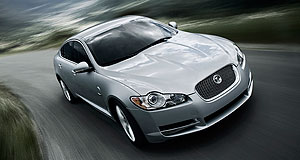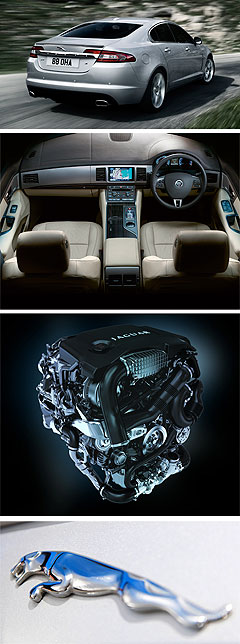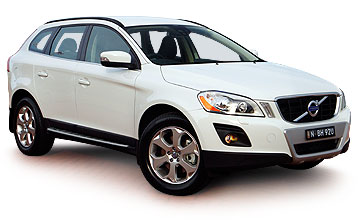 In the hood: The big changes for the 2009 Jaguar XF range lie under the bonnet.
In the hood: The big changes for the 2009 Jaguar XF range lie under the bonnet.
By DAVID HASSAL
Jaguar introduces 3.0-litre V6 diesel and 5.0-litre V8 petrol to mid-size XF rangeONE year after launching the all-new XF saloon in Australia as the replacement to the underachieving S-Type, Jaguar Australia is about to unleash a substantially revised range with several notable new engines.
As well as the supercharged V8 in the new XFR flagship (see separate story), the regular V8 model benefits from a direct-injection 5.0-litre unit, while the diesel gains a greatly improved 3.0-litre V6, leaving the 3.0-litre petrol V6 as the only carryover engine in the 2009 model range.
The new XF range was launched to the media this week, but does not arrive in Jaguar showrooms until August.
Prices have increased slightly, with the entry-level petrol V6 rising $1100 to $109,450 while gaining some minor trim and specification changes such as an upgraded SatNav system.
Although the previous 2.7-litre turbo-diesel model carried the same entry-level price as the petrol, the new 3.0-litre diesel will command a $6800 premium with a list price of $116,250.
The normally-aspirated V8 petrol model XF jumps considerably by moving to an all-new direct-injection 5.0-litre unit and is now listed at $147,900 – some $13,070 more than the outgoing 4.2-litre model.
Both of the new engines are not only considerably more powerful than the units they replace, but are more environmentally and back-pocket friendly with improved fuel economy and emissions.
 Left: Jaguar XF Diesel.
Left: Jaguar XF Diesel.The 3.0-litre V6 turbo-diesel engine – again developed in conjunction with PSA Peugeot-Citroen, like the 2.7 – comes to Australia only in the higher-output of two specifications available overseas.
With 202kW of power at 4000rpm and 600Nm of torque at 2000rpm, the engine is 33 per cent more powerful than the 2.7-litre unit while cutting both fuel consumption (6.8L/100km) and carbon emissions (179g/km) by 10 per cent.
Most of the engine’s torque is available almost instantly, enabling the diesel-powered XF to accelerate from rest to 100km/h in just 6.4 seconds – 1.9 seconds faster than the V6 petrol and only 0.7 seconds shy of the petrol V8 model.
Jaguar Cars’ chief powertrain engineer Ron Lee said the V8 levels of performance from low revs were down to a new parallel sequential turbocharger system, which he claimed is the first of its type to be fitted to a V-engine anywhere in the world.
“The engine can deliver 500Nm torque from standstill in just 500 milliseconds, which is a remarkable achievement,” said Mr Lee.
“It’s a power unit that delivers superb flexibility and remarkably low fuel consumption and emissions, while building on the refinement that has become a trademark of our Jaguar diesel engines.”
Mr Lee said the twin turbochargers worked sequentially to deliver high levels of torque throughout the rev range, improved throttle response and low CO2 emissions that met Euro V levels.
“For most day-to-day driving, including motorway cruising, a responsive, variable-geometry primary turbocharger does all the work, while the smaller, fixed-geometry, secondary turbo is dormant, saving energy and improving efficiency,” Mr Lee explained.
“When the engine revs climb above 2800rpm, the secondary turbo is brought on line within 300 milliseconds, smoothly and seamlessly boosting the engine output with no discernible turbo-lag or power-step.
“Some twin-turbo systems rely on a smaller turbo for primary use, only using a larger turbo when higher power is required. Though effective, this has the disadvantage of raised exhaust pressure and increased pumping losses.
“The Jaguar system uses a larger, variable-geometry turbocharger more of the time, which not only reduces pumping losses, but also improves fuel consumption and CO2 emissions.”
As well as being more compact and lighter – it uses a compact graphite iron block rather than cast-iron – the new diesel also benefits from a third-generation commonrail injection system operating at 2000bar pressure, and a new water-cooled exhaust gas recirculation system.
The normally-aspirated 5.0-litre petrol V8 – like the supercharged version fitted to the XFR – is a new direct-injection unit employing an aluminium block with cast-in iron liners and cross-bolted main bearings, aluminium heads with four valves per cylinder and forged steel conrods.
It has been designed in-house and, for the first time at Jaguar, the blocks are high-pressure die-cast for greater accuracy and quality, using recycled aluminium alloy.
Relocating the oil pump inside the engine has shortened the V8 by 24mm over the previous 4.2-litre unit, keeping weight down and aiding engine bay packaging.
Producing 283kW at 6500rpm and 515Nm at 3500rpm, the V8 is 29 per cent more powerful than the 4.2, but has the same Euro V emissions level while returning a combined fuel consumption average figure of 11.1L/100km, thanks in part to a higher 11.5:1 compression ratio.
Standard transmission across the XF range remains the proven low-slip ZF six-speed auto, which can be switched to manual mode by pressing either of the two steering wheel change paddles.
| Jaguar XF range pricing: |
| XF 3.0L V6 (a) | $109,450 |
| XF 3.0L Diesel (a) | $116,250 |
| XF 5.0 N/A (a) | $147,900 |
| XFR (a) | $208,450 |


 Left: Jaguar XF Diesel.
Left: Jaguar XF Diesel.